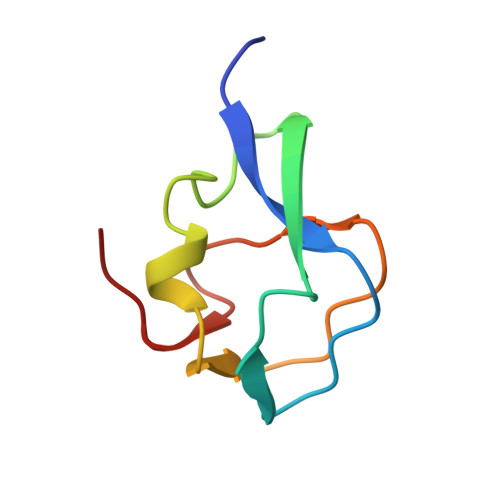The effects of steric mutations on the structure of type III antifreeze protein and its interaction with ice.
DeLuca, C.I., Davies, P.L., Ye, Q., Jia, Z.(1998) J Mol Biology 275: 515-525
- PubMed: 9466928
- DOI: https://doi.org/10.1006/jmbi.1997.1482
- Primary Citation of Related Structures:
2MSI, 3MSI, 4MSI, 5MSI, 6MSI, 7MSI - PubMed Abstract:
The interaction of proteins with ice is poorly understood and difficult to study, partly because ice is transitory and can present many binding surfaces, and partly because structures have been determined for only two ice-binding proteins. This paper focuses on one of these, a 66-residue antifreeze protein (AFP) from eel pout. The high resolution X-ray structure of this fish AFP demonstrated that the proposed ice-binding surface is remarkably flat for such a small protein. The residues on the planar surface thought to be involved in ice binding are restrained by hydrogen bonds or by tight packing of their side-chains. To probe the requirement for a flat binding surface, a conserved alanine in the center of the AFP planar surface was substituted with larger residues. Six alanine replacement mutants (Ala16 > Cys, Thr, Met, Arg, His and Tyr), designed to disrupt the planarity of the surface and sterically block binding to ice, were characterized by X-ray crystallography and compared with the wild-type AFP. In each case, the detail provided by these crystal structures has helped explain the effects of the mutation on antifreeze activity. The substitutions, Ala16 > His and Ala16 > Tyr, were large enough to shield Gln44, one of the putative ice-binding residues, contributing to their very low thermal hysteresis activity. In addition to sterically hindering the putative ice-binding site, the bulkier residues also caused shifts in the putative ice-binding residues owing to the tight packing of side-chains on the planar surface. This unexpected consequence of the mutations helps account for the severely reduced antifreeze activity. One explanation for residual antifreeze activity in some of the mutants lies in the possibility that AFPs have a role in shaping the site on the ice to which they bind. Thus, side-chain dislocations might be partially accommodated by ice that can freeze around them. It is evident that the disruption of the planarity, by introducing larger residues at the center of the proposed ice-binding site, is not the only factor responsible for the loss of antifreeze activity. There are multiple causes including positional change and steric blockage of some putative ice-binding residues.
- Department of Biochemistry, Queen's University, Kingston, Ontario, Canada.
Organizational Affiliation:
















